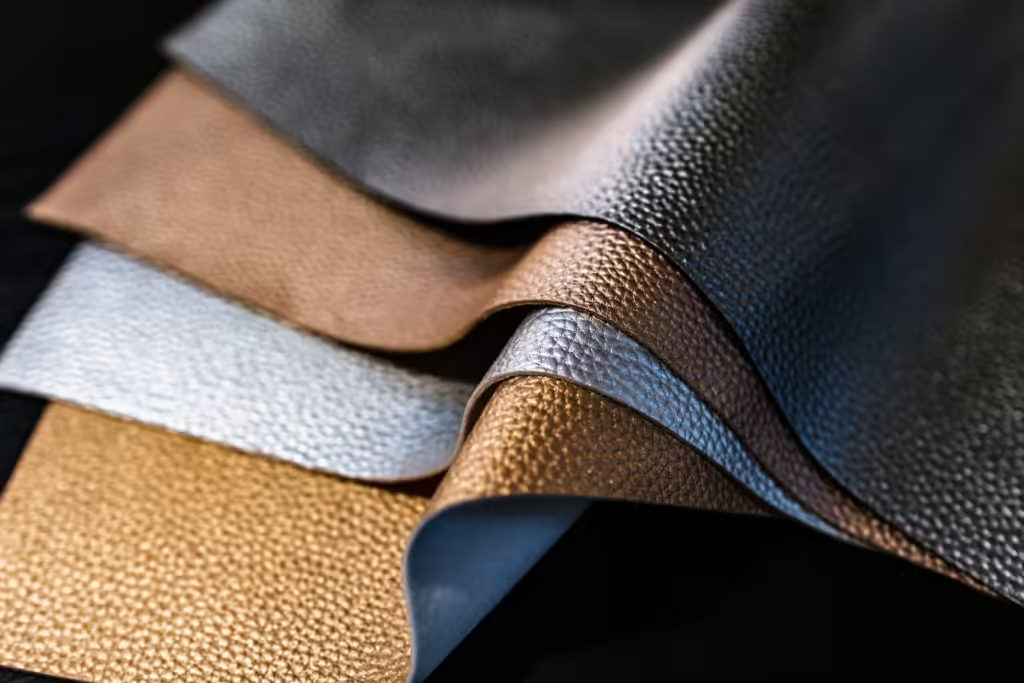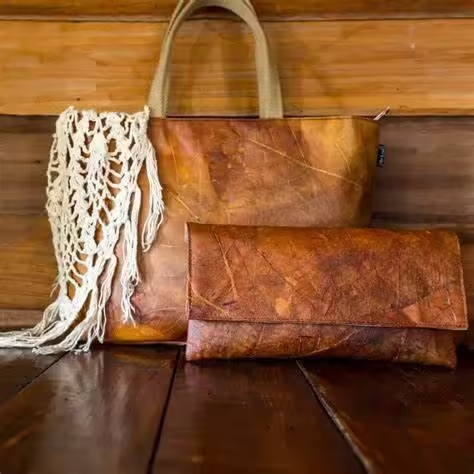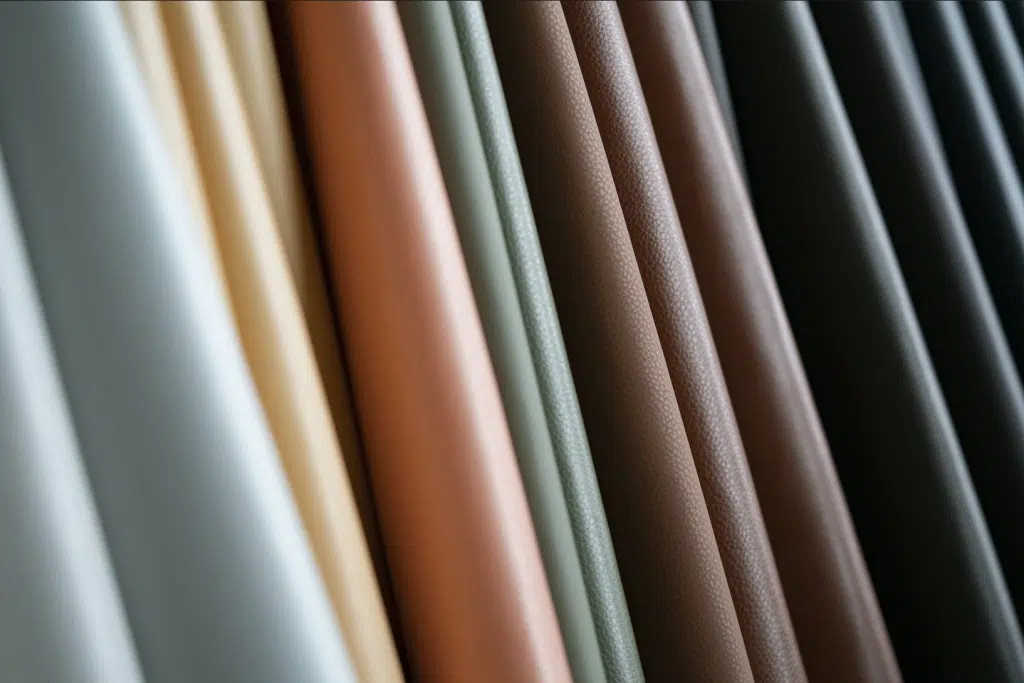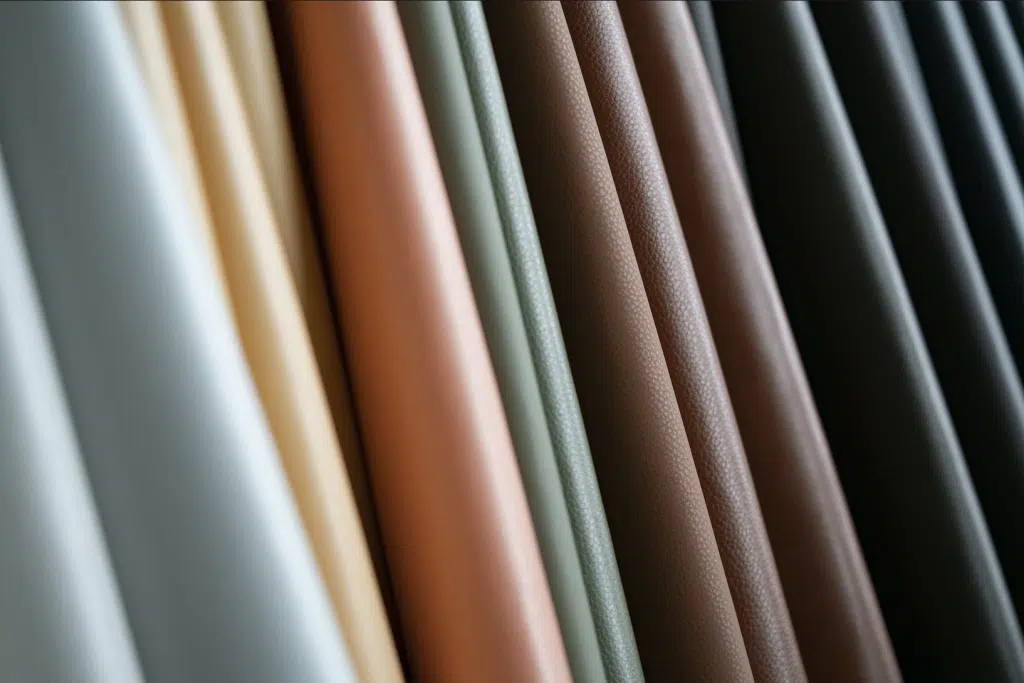In recent years, the fashion industry has witnessed a significant shift toward sustainability, with eco-conscious consumers seeking alternatives that align with their values.
At the forefront of this movement is vegan leather, a material that offers a cruelty-free substitute for traditional animal leather while minimizing environmental impact. So, what exactly is vegan leather?
In its essence, vegan leather refers to synthetic or plant-based textiles that mimic the appearance and texture of leather without the use of animal products.
One popular variety is polyurethane leather, which is crafted from polymer materials and provides a stylish yet more sustainable choice for fashion enthusiasts.
As we delve deeper into the world of sustainable fashion, we’ll explore an array of exciting vegan leather alternatives that not only elevate your wardrobe but also contribute to a healthier planet.
Understanding the Benefits of Vegan Leather for a Cruelty-Free Wardrobe
As the world increasingly shifts toward sustainable fashion, the demand for materials that are both eco-friendly and cruelty-free is rising. Vegan leather, often referred to as vegetarian leather, has emerged as a popular alternative to traditional leather, providing a solution that appeals to the ethical consumer.
The vegan leather meaning centers around its base materials and production processes, which do not involve the use of animal products, making it an attractive choice for individuals committed to a cruelty-free lifestyle.
This growing trend not only supports animal welfare but also offers a chance to reduce the environmental impact associated with conventional leather production.
One of the primary benefits of vegan leather is its versatility and range of options. Made from a variety of materials such as polyurethane, cork, or even recycled plastics, it can mimic the look and feel of genuine leather without the ethical baggage.
Fashion brands are increasingly incorporating vegetarian leather into their collections, producing everything from stylish jackets and handbags to shoes and accessories.
The wearability of vegan leather in diverse styles means that consumers don’t have to sacrifice aesthetics for their principles; instead, they can express their individuality while supporting a more ethical fashion industry.
Moreover, vegan leather is often easier to maintain compared to traditional leather. Many alternatives are water-resistant and can be cleaned with a simple wipe, making them practical for everyday use.
Additionally, the progress in technology means that the quality of vegetarian leather continues to develop, providing consumers with durable products that can withstand the test of time. This durability not only enhances the lifespan of items but also reinforces the principles of sustainability by encouraging responsible consumption and reducing waste in the long run.
In conclusion, the shift toward vegan leather signifies more than just a trend; it represents a broader movement within the fashion industry that prioritizes ethical consumption and environmental stewardship.
As consumers become more aware of the implications of their choices, adopting vegetarian leather products can be a powerful statement. By building a wardrobe that features vegan leather items, individuals can enjoy stylish and functional pieces while making a positive impact on animal welfare and the planet. Embracing this shift can be both a fashionable and responsible decision, reshaping the future of fashion for generations to come.

Exploring Eco-Friendly Choices: Vegan Leather vs. Traditional Leather
As consumers become increasingly aware of the environmental impact of their purchasing decisions, the demand for sustainable products has grown significantly. Two popular materials that often come under scrutiny are traditional leather and its eco-friendly counterparts, such as vegan leather.
While traditional leather is derived from animal hides, its production is resource-intensive and comes with ethical concerns regarding animal welfare. On the other hand, vegan leather alternatives have emerged as a more sustainable choice, offering a variety of benefits that cater to eco-conscious shoppers.
These alternatives can range from synthetic materials, like polyurethane, to more innovative options made from plant-based resources such as pineapple leaves or apple peels.
One of the primary advantages of vegan leather is its reduced environmental footprint. Traditional leather processing often involves toxic chemicals, significant water usage, and land degradation associated with livestock farming.
In contrast, many vegan leather alternatives are designed to minimize these impacts, using more sustainable production processes. For instance, plant-based leathers can utilize agricultural waste, which helps to reduce waste while providing a biodegradable option at the end of their life cycle.
This shift not only lessens the burden on natural resources but also contributes to a circular economy, where products are reimagined and repurposed rather than discarded.
However, it is essential to understand that not all vegan leather alternatives are created equal. Some synthetic options may still rely on fossil fuels and are not biodegradable, raising questions about their long-term sustainability. As consumers, it becomes crucial to assess the overall lifecycle of these products, including their production, durability, and end-of-life scenarios.
Many companies are now transparent about their manufacturing processes and materials, allowing consumers to make informed choices that align with their values. By researching and selecting high-quality vegan alternatives that prioritize eco-friendly practices, individuals can confidently contribute to a more sustainable fashion industry.
In the grand scheme of things, the decision between traditional leather and vegan leather alternatives ultimately comes down to personal values and priorities. Those prioritizing environmental sustainability and ethical considerations may find that vegan leather offers a compelling solution.
Yet, it is vital to remain critical and vigilant about the materials we choose, understanding the broader implications of our purchases and how they impact the planet. By embracing eco-friendly choices, consumers can play a significant role in fostering positive change within the fashion industry and promoting a more sustainable future for all.
How to Spot High-Quality Vegan Leather Products
As the demand for sustainable and ethical fashion continues to rise, many consumers are turning to vegan leather alternatives as a cruelty-free option. However, not all vegan leather products are created equal. To ensure that you’re investing in high-quality items, it’s important to know what to look for when evaluating these products.
The first indicator of quality is the material itself. Premium vegan leather is usually made from high-grade polyurethane (PU) or other innovative materials like pineapple leather or mushroom leather, which offer durability and a luxurious feel. Cheaper alternatives often use PVC, which is less environmentally friendly and may wear out more quickly.
Another essential factor to consider is the craftsmanship. High-quality vegan leather products should exhibit attention to detail in stitching, alignment, and finishing. Look for even seams and strong construction, as these elements contribute to the longevity of the item.
Collected sample swatches or looking at the product up close can help you gauge its texture and flexibility. High-quality vegan leather should mimic the look and feel of genuine leather without compromising on comfort, while lesser alternatives may feel stiff or overly shiny.
Beyond the materials and craftsmanship, brand reputation plays a significant role in determining the quality of vegan leather alternatives. Brands committed to ethical practices and sustainability tend to prioritize the materials and processes used in their products. Research the company’s values and manufacturing methods; transparency about sourcing and production can be strong indicators of a high-quality product. Additionally, reading customer reviews can provide insights into the longevity and performance of the vegan leather items you’re considering.
Finally, consider the product’s warranty or guarantee policy. Reputable brands often back their products with warranties that reflect their confidence in quality and durability. A good warranty can be a safety net, ensuring that you won’t be left with a subpar product if it doesn’t meet your expectations. By keeping these factors in mind when shopping for vegan leather alternatives, you can make informed choices that align with your values and deliver the quality you desire.
Top Brands Leading the Way in Sustainable Vegan Leather Fashion
As the fashion industry grapples with its environmental impact, an increasing number of brands are stepping up to lead the charge in sustainable fashion, particularly in the realm of vegan leather alternatives. These innovative materials are crafted to minimize harm to the planet while offering consumers stylish options that align with their values. Prominent brands are paving the way by integrating these materials into their collections, challenging the traditional leather market and appealing to the growing demographic of eco-conscious consumers.
One standout brand making waves is Stella McCartney, renowned for her commitment to sustainability. McCartney has consistently championed vegan leather alternatives, using materials like Piñatex—crafted from pineapple leaves—and sustainable polyurethane to create stylish clothing and accessories. Her dedication extends beyond materials; the brand actively promotes ethical production practices, making them a leader in the fashion sustainability movement. This focus not only resonates with ethically-minded consumers but also sets a benchmark in the luxury fashion segment.
Another noteworthy player is Veja, a footwear brand that employs a plethora of sustainable materials, including innovative vegan leather alternatives made from recycled plastics and other eco-friendly components. By focusing on transparency, fair trade practices, and environmental responsibility, Veja has cultivated a loyal following among consumers who want to make choices that reflect their values. Their trendy sneaker designs demonstrate that fashion doesn’t have to compromise on ethics, proving that it’s possible to be both stylish and sustainable.
In the realm of affordable fashion, brands like Matt & Nat are redefining vegan leather through stylish handbags and accessories crafted from recycled plastics. Their collections emphasize functionality and design while highlighting the importance of sustainability. By prioritizing vegan leather alternatives, these brands not only offer chic choices for consumers but also foster a broader understanding of sustainable consumption, encouraging individuals to consider the environmental implications of their fashion choices. As more brands adopt a commitment to vegan leather alternatives, the future of fashion looks promising for both eco-conscious consumers and the planet.

DIY: Creating Your Own Vegan Leather Accessories at Home
Creating your own vegan leather accessories at home is an enjoyable and resourceful way to embrace sustainability while expressing your personal style. With a variety of vegan leather alternatives available today, such as cork, apple leather, and even pineapple leather, the possibilities are endless. These materials are not only eco-friendly but also versatile, allowing you to experiment with textures, colors, and designs. Plus, crafting your own accessories means you can customize them to suit your taste and needs perfectly.
To get started, gather your supplies. You’ll need vegan leather alternatives, sturdy scissors, a sewing machine or needle and thread, and the necessary decorative elements like buttons or studs. Begin by selecting a pattern for your accessory, whether it’s a wallet, handbag, or bracelet. There are numerous free patterns available online to guide your design. Once you’ve selected your design, cut out the material, keeping in mind that vegan leathers may require slightly different handling compared to traditional leather.
Sewing the pieces together is perhaps the most exciting part of the process. While some vegan leather alternatives can be stitched easily, others may require special needles or techniques for optimal results. As you sew, you might find it enjoyable to incorporate unique embellishments that reflect your personality — from colorful threads to bold hardware. Keep your finished piece in mind as a canvas that showcases your creativity and commitment to sustainable fashion.
Finally, once you’ve completed your DIY accessory, take a moment to celebrate your achievement. Not only have you created something unique and stylish, but you’ve also made a conscious choice to support alternative materials over traditional leather. As vegan leather alternatives continue to evolve and garner popularity, your handmade creations become a statement in promoting a more sustainable lifestyle. So gather your materials, unleash your creativity, and enjoy the rewarding experience of crafting your own vegan leather accessories.
The Environmental Impact of Vegan Leather Production
In recent years, the demand for vegan leather alternatives has surged as consumers increasingly seek sustainable options for fashion and accessories. Unlike traditional leather, which is derived from animal hides and often involves resource-intensive processes, vegan leather aims to minimize environmental impact. However, the production of these alternatives comes with its own set of environmental concerns that cannot be overlooked. Many vegan leathers are made from synthetic materials such as polyurethane (PU) or polyvinyl chloride (PVC), which are derived from fossil fuels and can contribute to plastic pollution.
The environmental impact of producing synthetic vegan leather is significant. The extraction and processing of fossil fuels for these materials can lead to habitat destruction, greenhouse gas emissions, and a host of health risks for surrounding communities. Additionally, unlike natural leather that can biodegrade over time, some synthetic alternatives do not break down easily and can persist in landfills for decades or even centuries. Furthermore, the production processes can involve harmful chemicals that, while potentially safer than those used in conventional leather tanning, still pose environmental hazards if not managed properly.
On the other hand, there are innovative vegan leather alternatives that utilize sustainable resources, such as pineapple leaves, apple peels, or mycelium. These bio-based materials are often more environmentally friendly, as they tend to require less water and energy to produce and are biodegradable, thus reducing their long-term ecological footprint. The rise of these sustainable materials indicates a growing awareness of the need for alternatives that respect the planet and animal welfare. However, scaling up production of these innovative materials remains a challenge, as they often require specific agricultural practices and supply chains that are not yet widely established.
In conclusion, while vegan leather alternatives present an opportunity to reduce reliance on animal products and lessen the environmental toll of the fashion industry, it is essential to consider their production methods and materials carefully. As consumers continue to drive demand for sustainable options, the focus must be on developing and promoting truly eco-friendly vegan leather that prioritizes both planet and people. Only by addressing these complexities can the fashion industry hope to create a more sustainable future that aligns with ethical values and environmental stewardship.
Styling Tips for Incorporating Vegan Leather into Your Wardrobe
In recent years, vegan leather alternatives have surged in popularity, both for their ethical considerations and the diverse style options they offer. Transitioning to materials that avoid animal products doesn’t mean sacrificing fashion. Instead, it opens up a world of creativity in how you style your outfits. One effective approach to integrating vegan leather into your wardrobe is by mixing textures. Pair a sleek vegan leather jacket with soft fabrics like cotton or silk to create a balanced look that’s both polished and edgy. This juxtaposition helps you leverage the versatility of vegan leather while adding depth to your ensemble.
Another key styling tip is to embrace layering. A vegan leather skirt can serve as a chic base layer under an oversized sweater or a long duster coat, creating a stylish, cozy outfit perfect for any season. When it comes to color, black is traditionally associated with vegan leather, but today’s alternatives come in an array of shades. Don’t hesitate to experiment with muted pastels or bold hues like burgundy or emerald green. These vibrant options can redefine your wardrobe staples and help you stand out while maintaining a contemporary aesthetic.
Accessories also play a vital role in maximizing the potential of vegan leather alternatives. Consider incorporating vegan leather handbags, belts, or shoes into your outfits to complete your look seamlessly. These accessories can serve as statement pieces or subtle accents, depending on how bold you want to be. For instance, a structured vegan leather bag can elevate a casual outfit, while a pair of vegan leather ankle boots can add a rugged touch to a feminine dress. By selectively choosing your accessories, you can enhance your overall look without overwhelming it.
Lastly, remember that confidence is your best accessory. No matter how you incorporate vegan leather into your fashion repertoire, wearing your outfits with self-assuredness will always make a statement. Embrace the benefits of vegan leather alternatives as not just a trend, but a sustainable lifestyle choice that reflects your personal style. With thoughtful combinations and an adventurous spirit, you can create stunning outfits that embody both fashion and your commitment to ethical living.
A Quick Guide to Caring for Your Vegan Leather Items
Vegan leather, also known as synthetic leather or faux leather, has gained immense popularity as a stylish and cruelty-free alternative to traditional leather. Made from a variety of materials like polyurethane (PU), polyvinyl chloride (PVC), or even innovative options like apple peels and pineapple leaves, vegan leather alternatives are not only diverse in appearance but also vary in their durability and maintenance needs. To ensure that your vegan leather items remain in great condition, it’s essential to understand the proper care techniques.
First and foremost, cleaning your vegan leather is crucial to maintaining its appearance and longevity. Unlike real leather, which may require specialized cleaners, most vegan leather can be cleaned with a damp cloth and mild soap. Simply wipe away dirt and stains gently, taking care not to saturate the material. For deeper cleaning, consider using a solution of water and a few drops of mild detergent, but always remember to perform a patch test on a hidden area first to ensure that the color and texture hold up.
In addition to regular cleaning, protecting your vegan leather items from extreme temperatures and moisture is vital. Synthetic materials can react poorly to intense heat, leading to warping or cracking. Keep your vegan leather away from direct sunlight for extended periods and avoid leaving it in hot cars. Moisture can also pose a threat; while some vegan leather is more resistant to water than others, it’s best to treat your items with a water-repellent spray designed specifically for synthetic materials. This can help prevent stains and damage from spills, keeping your items looking fresh and new.
Finally, store your vegan leather items properly to extend their life. Avoid hanging items that may stretch out, and instead, opt for neatly folded storage or use padded hangers for bags. Always make sure they are placed in a cool, dry area away from sharp objects that could scratch the surface. With the right care, your vegan leather alternatives can provide you with a chic, ethical choice for years to come, proving that style and sustainability can go hand in hand.
READ THIS ALSO: Find Perfect Camping Sites Near Me | Adventure Awaits
Vegan Leather Innovations: What’s Next for Sustainable Fashion
As the fashion industry increasingly grapples with its environmental impact, the rise of vegan leather innovations is capturing the spotlight. Traditionally made from materials like polyurethane or polyvinyl chloride, vegan leather offered a cruelty-free alternative to animal hide but often came with its own set of environmental concerns. Now, new advancements are paving the way for more sustainable options that mitigate these effects and appeal to eco-conscious consumers.
Recent innovations in vegan leather alternatives are venturing beyond synthetic materials, tapping into agricultural byproducts such as apple peels, mushrooms, and even waste from pineapple production. These alternative sources not only reduce dependency on fossil fuels but also provide a circular solution that utilizes materials that would typically go to waste. For instance, products like Apple Leather have come to market, showcasing the potential for repurposing what might otherwise be discarded into stylish, eco-friendly goods. This shift speaks to a broader trend in sustainable fashion, where the focus is not only on the end product but also the entire lifecycle of materials used.
Furthermore, advancements in technology are playing a significant role in the evolution of vegan leather. Innovations like 3D printing and bio-fabrication are enabling designers to create custom materials that are both durable and biodegradable. These technologies offer unprecedented flexibility and creativity for fashion brands looking to differentiate themselves while adhering to sustainable practices. As these methods become more refined and accessible, the gap between traditional leather and its plant-based counterparts continues to narrow.
The future of vegan leather alternatives looks promising, with sustainability at its core. As consumers become more attuned to the environmental implications of their purchases, brands that embrace innovation in this space will likely gain a competitive edge. The ongoing experimentation in materials—from mycelium to fruit-based leathers—indicates a transformational shift in how the fashion industry conceptualizes materials and their origins. Ultimately, the path forward is not just about replacing one material with another, but redefining the relationship between fashion, sustainability, and consciousness.

Embracing Conscious Consumerism: Making the Switch to Vegan Leather
In recent years, there has been a notable shift in consumer preferences towards products that not only meet aesthetic demands but also align with ethical values. Embracing conscious consumerism has led many to explore vegan leather alternatives that offer both sustainability and style without compromising on quality. This shift is largely driven by a growing awareness of the environmental and ethical implications associated with traditional leather production, including animal welfare concerns and the significant resources required for tanning and processing.
Vegan leather alternatives have evolved significantly, with innovations ranging from materials derived from plants, such as pineapple leaves, apples, or mushrooms, to synthetic options that are designed to mimic the look and feel of real leather while minimizing environmental impact. These alternatives present a viable solution for those seeking to reduce their carbon footprint and support sustainable practices. Consumers now have access to a wider array of products made from these materials, ranging from handbags and shoes to furniture and automotive accessories, demonstrating that it is indeed possible to achieve both luxury and responsibility.
Adopting vegan leather not only supports animal rights but also contributes to a larger movement toward reducing waste and promoting circular economies. Many brands committed to conscious consumerism are incorporating recycled materials into their production processes, further lessening their impact on the planet. Additionally, as public demand for sustainable options continues to rise, more companies are prioritizing eco-friendly practices, leading to a more competitive market that reflects the values of today’s consumers.
Ultimately, the decision to switch to vegan leather alternatives represents a lifestyle choice that aligns personal style with a commitment to sustainability. By consciously choosing products that are ethical and environmentally friendly, consumers can play a vital role in driving change within the fashion and design industries, fostering a future where compassion and conscious consumption go hand in hand. As the world increasingly embraces these values, the power of informed choices can pave the way for a more sustainable and ethical marketplace.
Share this content:


2 thoughts on “Discover Sustainable Vegan Leather Alternatives For Eco-Friendly Fashion”